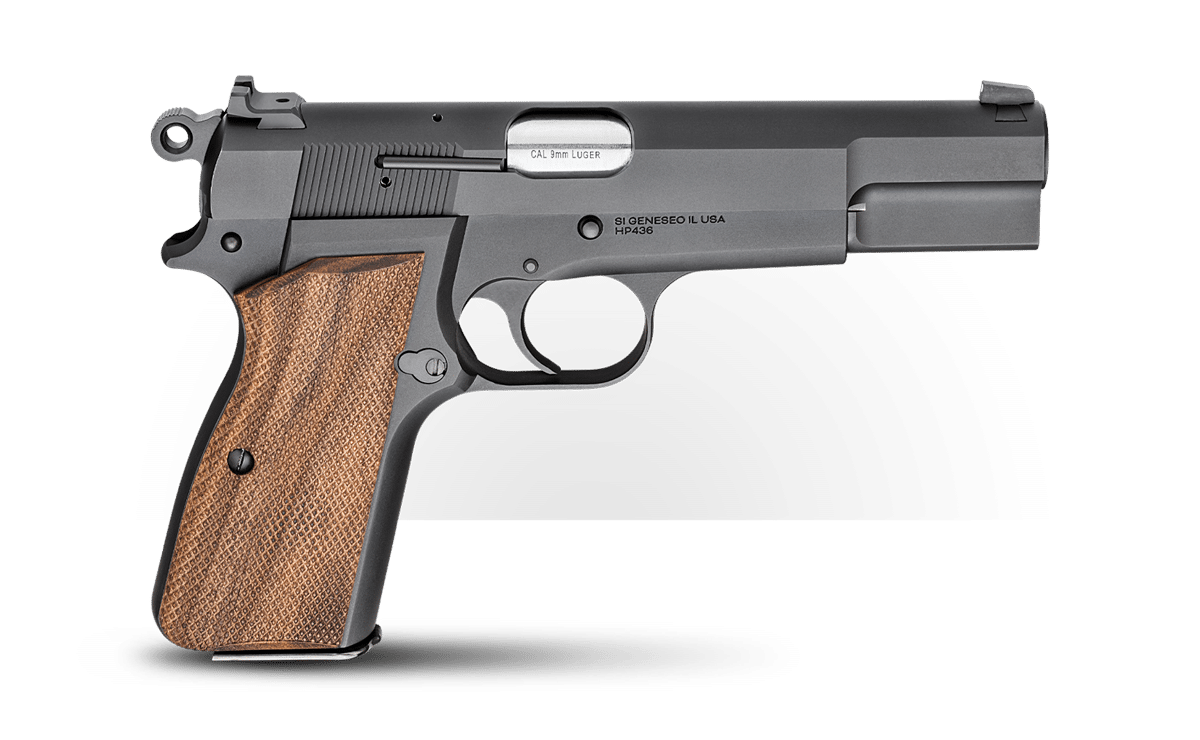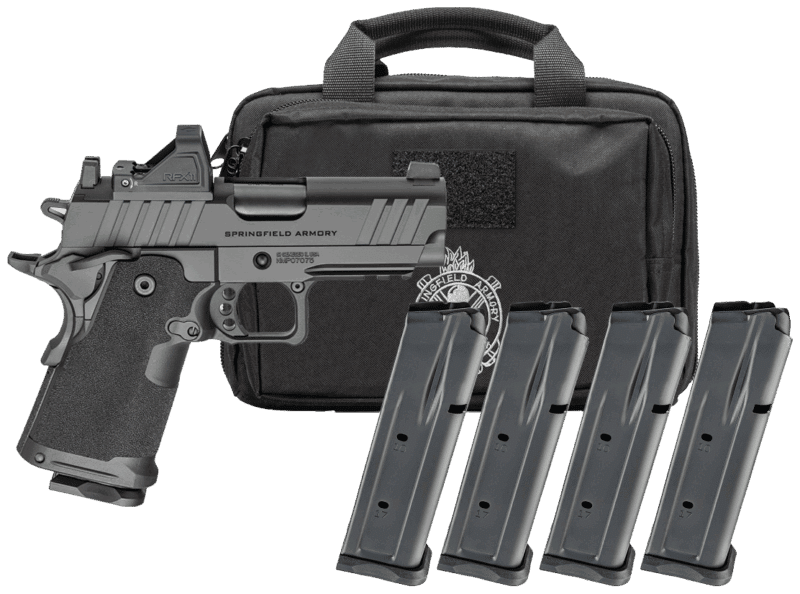SA-35 Review: Dissecting Springfield’s New 9mm Pistol
October 1st, 2025
11 minute read
On October 26, Springfield shook the world with the introduction of the SA-35, an updated version of the venerable P-35 9mm pistol. The response to the pistol was overwhelming, as was the demand for pistols. As I write this article, that demand has no sign of ceasing.
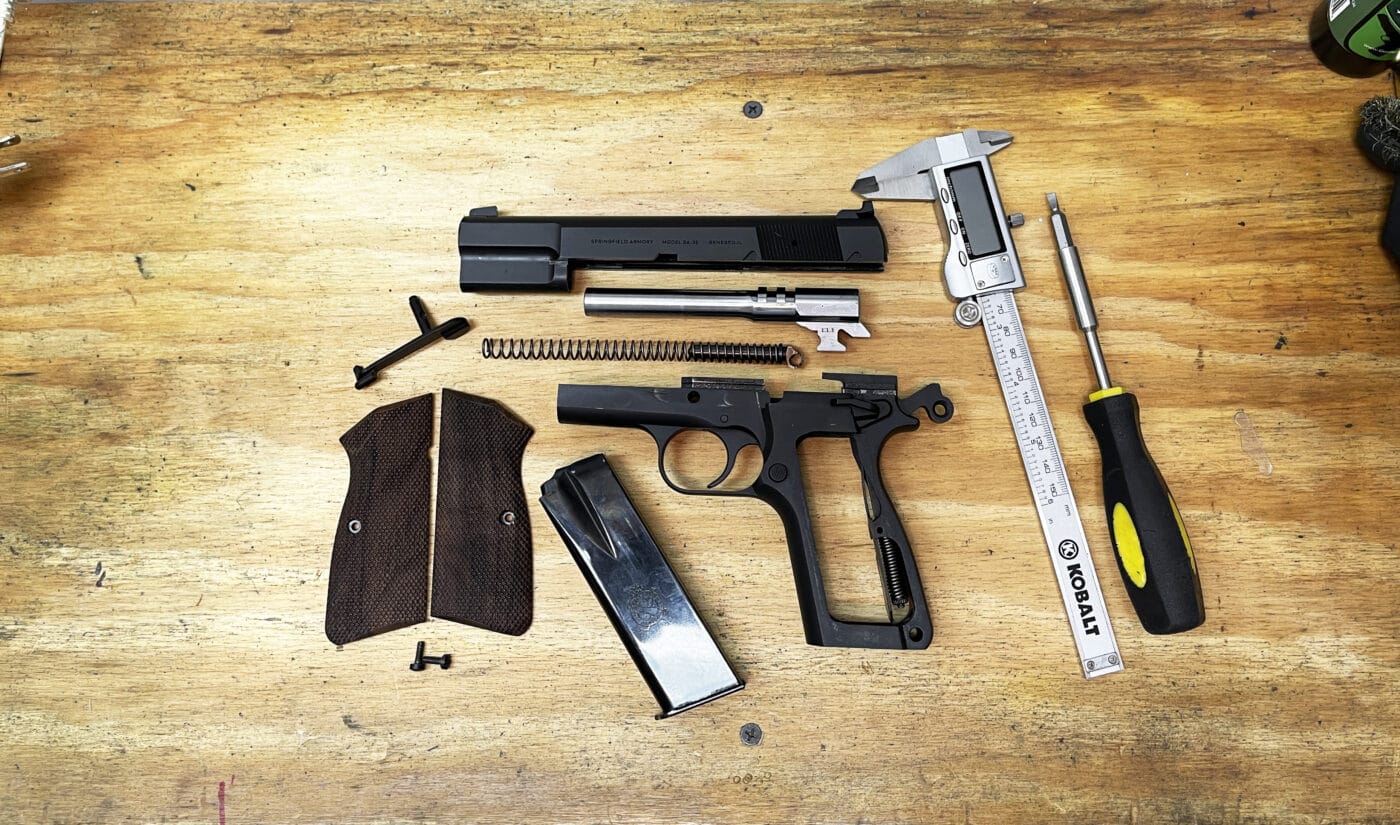
Normally, when I receive a pistol for editorial coverage, I run three premium loads through it for accuracy and velocity results. Then I run a box or two of ball through it for photographs and fun. However, when I received my SA-35 I decided to do an extensive testing protocol because I was so excited about it. Therefore, this column will cover my initial impressions and the results of the tests.
First Impressions of the SA-35
Let me say that I think the SA-35 is a homerun for Springfield in many ways. First, it is a faithful rendition of the original design, with modern upgrades that make it serviceable right out of the box. Second, the manufacturing and finish on the SA-35 are not only excellent but better than some originals I have seen in the past. Let me briefly hit what I consider the high points of the SA-35.
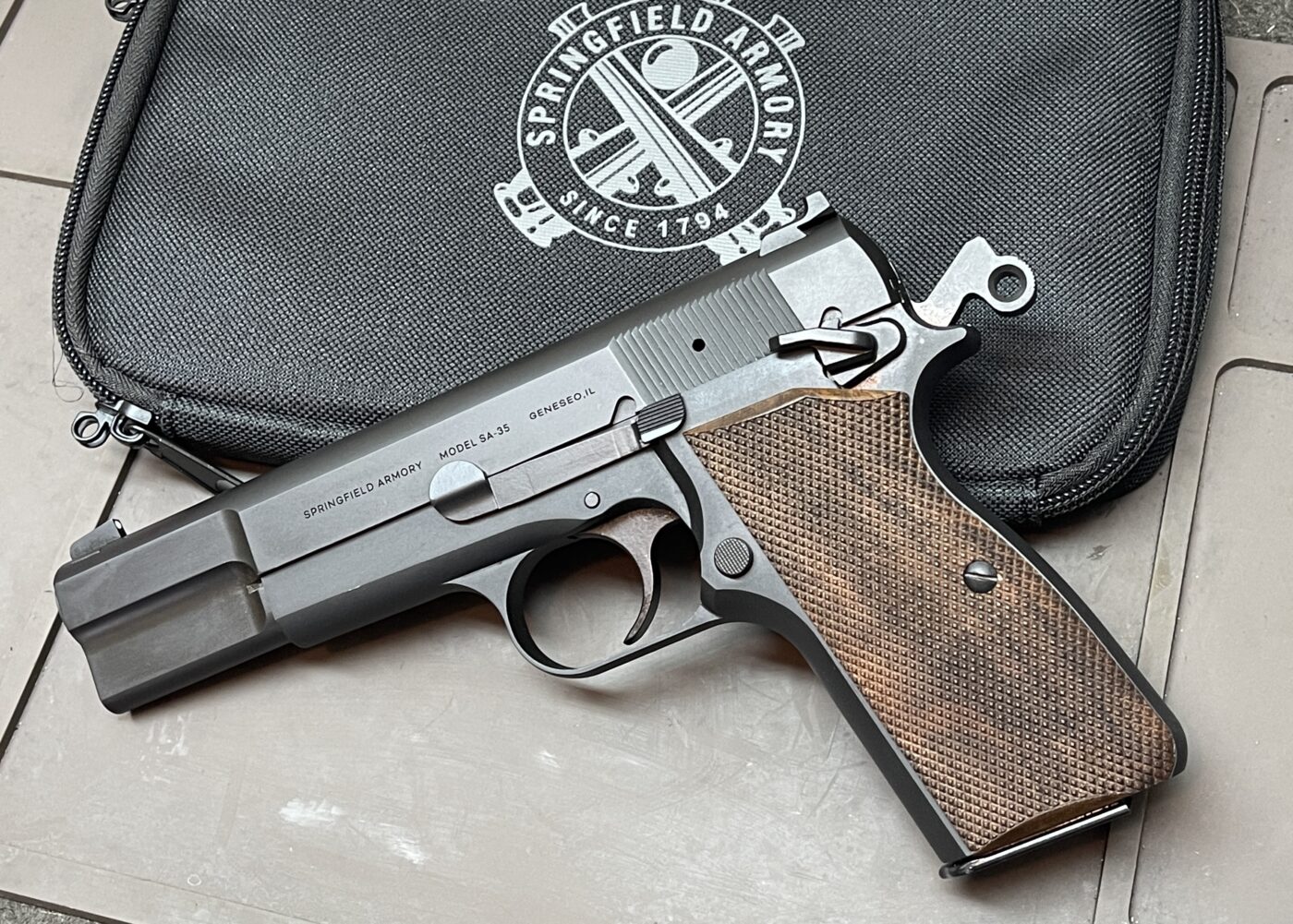
Matte Blue Finish
Springfield gave the SA-35 a matte blue finish. While not as durable as some of the “spray and bake” finishes, it is both attractive and fits the personality of the SA-35. Some of us remember the horrible painted finishes on original guns! This gun should be blued.
SA-35 Features
The no-bite ring hammer, excellent sights, beveled magazine well, extended safety and great trigger set the SA-35 apart from the imports. The use of a proven 15-round magazine negates any trivial critiques about capacity.
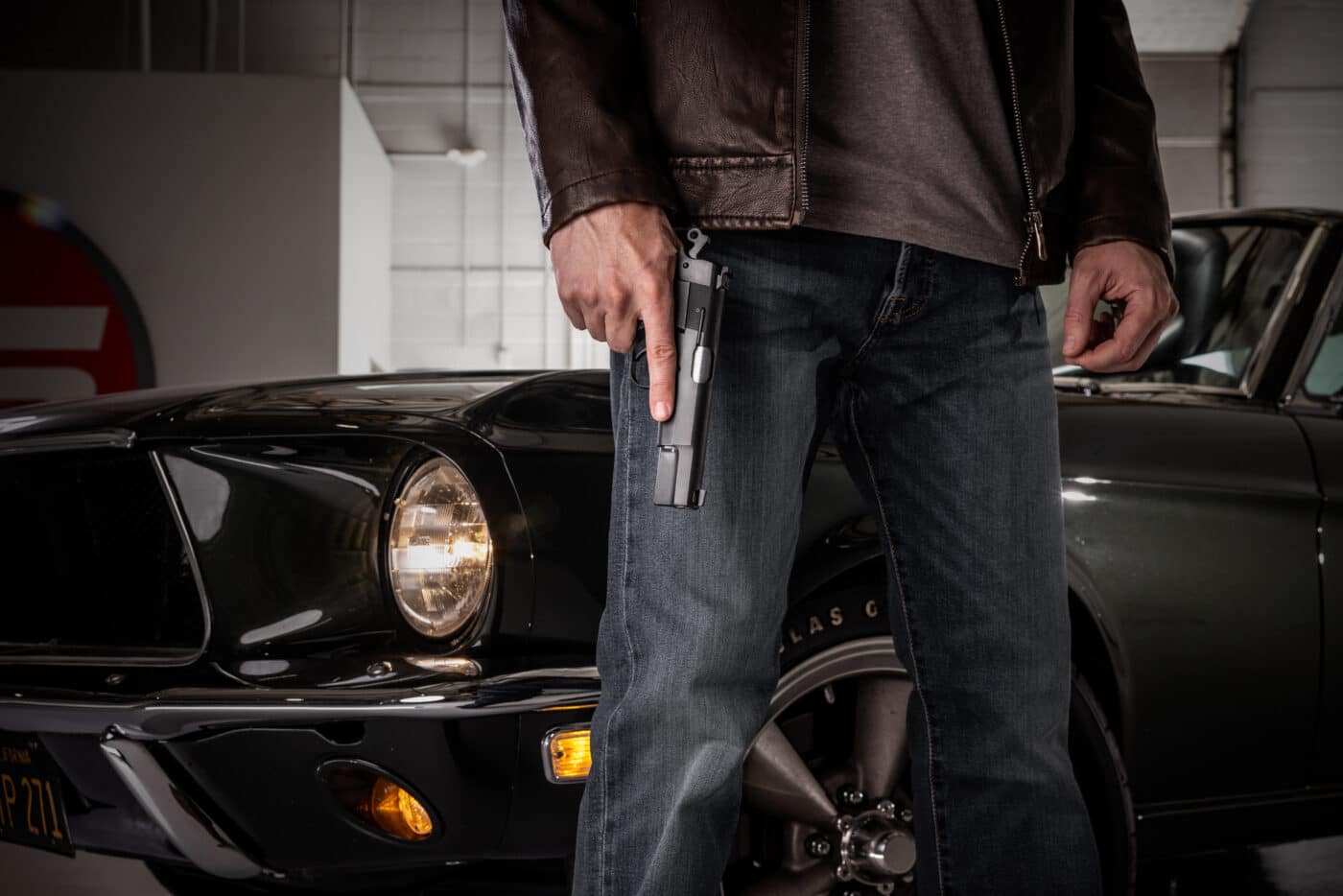
Springfield Armory Barrel
The hammer-forged barrel, and barrel fit, is exceptional. Bill Laughridge, of Cylinder & Slide fame, said that the barrel lock-up on the original pistol was atrocious and, in many cases, you were lucky to get them to shoot four inches at 25 yards. My SA-35 results were half of the old standard.
Contoured Wood Stocks
Kudos to Springfield for equipping the SA-35 with contoured wood stocks. The original stocks were not only thick but had no real contour on the edges. The SA-35 stocks are very similar to Spegels and taper to meet the frame with no overlap.
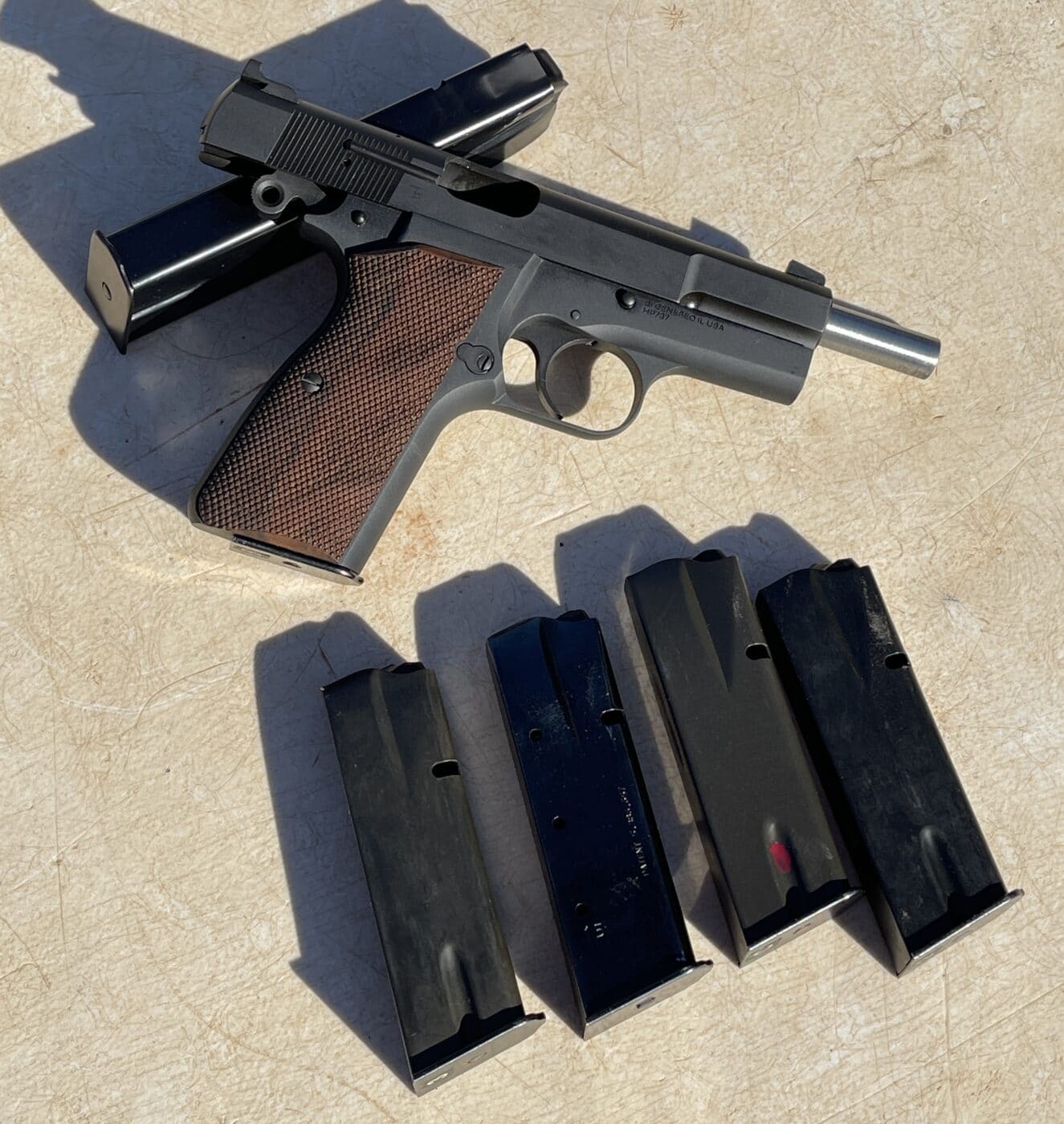
Slide to Frame Fit
The slide to frame fit, on my gun, is significantly better than on most original guns.
Hi-Power Aesthetics
Externally, the finish was void of any machine marks. The markings were clean and minimal. I was glad to see Springfield decided to forego their typical logo of the crossed cannons on the exterior of the gun. In my opinion, it just would not have looked right!
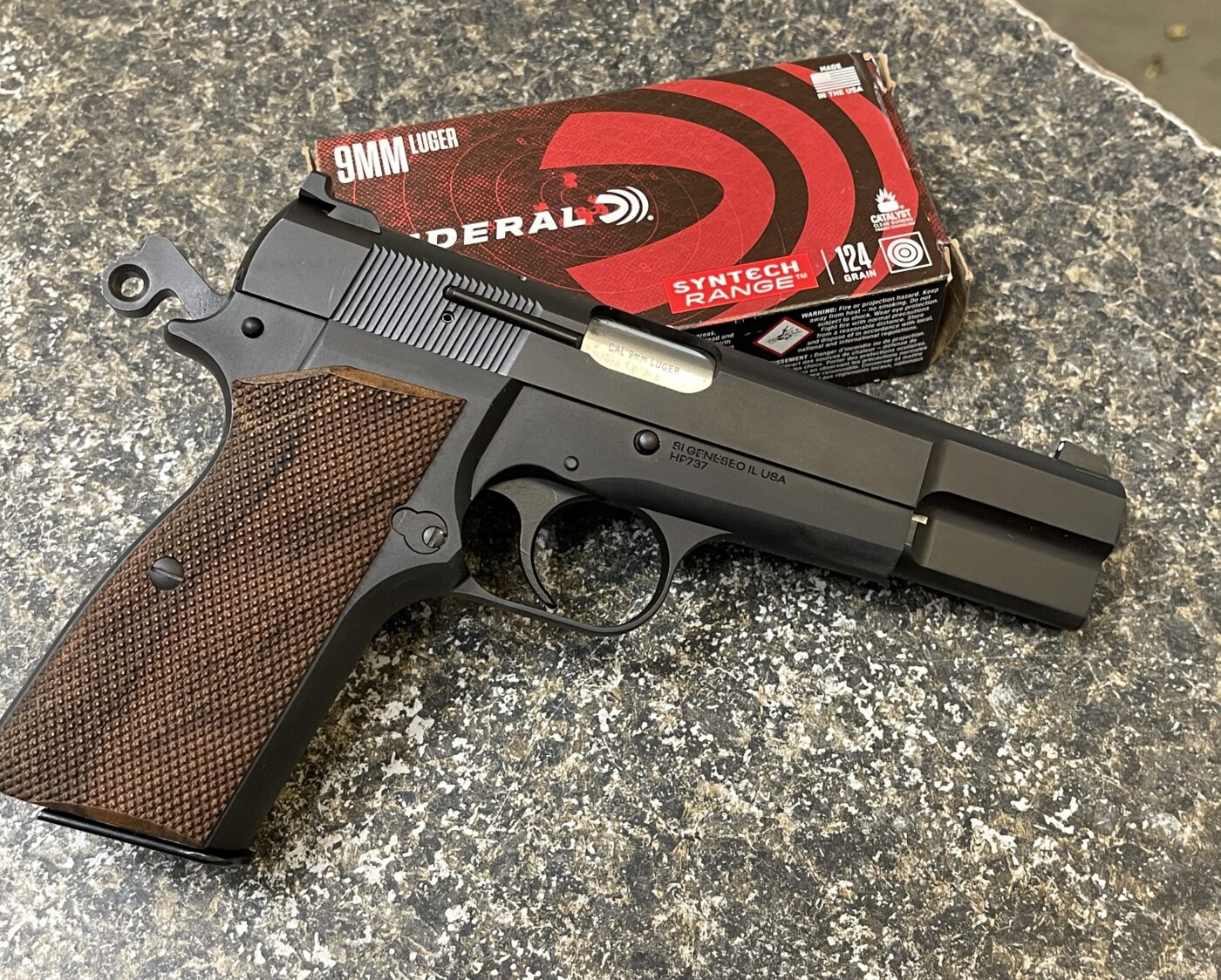
Internal Examination
Breaking the pistol down, there were some chatter marks on the top of the rails and bottom edge of the slide. This is purely cosmetic and are found on originals as well. Other than that, all machines was crisp and clean. The barrel was properly throated and the feed ramp was polished.
Shots Fired: Range Testing the SA-35 Pistol
The ammo shortage has certainly changed the manner in which many writers conduct evaluations. However, I wanted to gather as much information on the SA-35 as possible, given certain limitations.
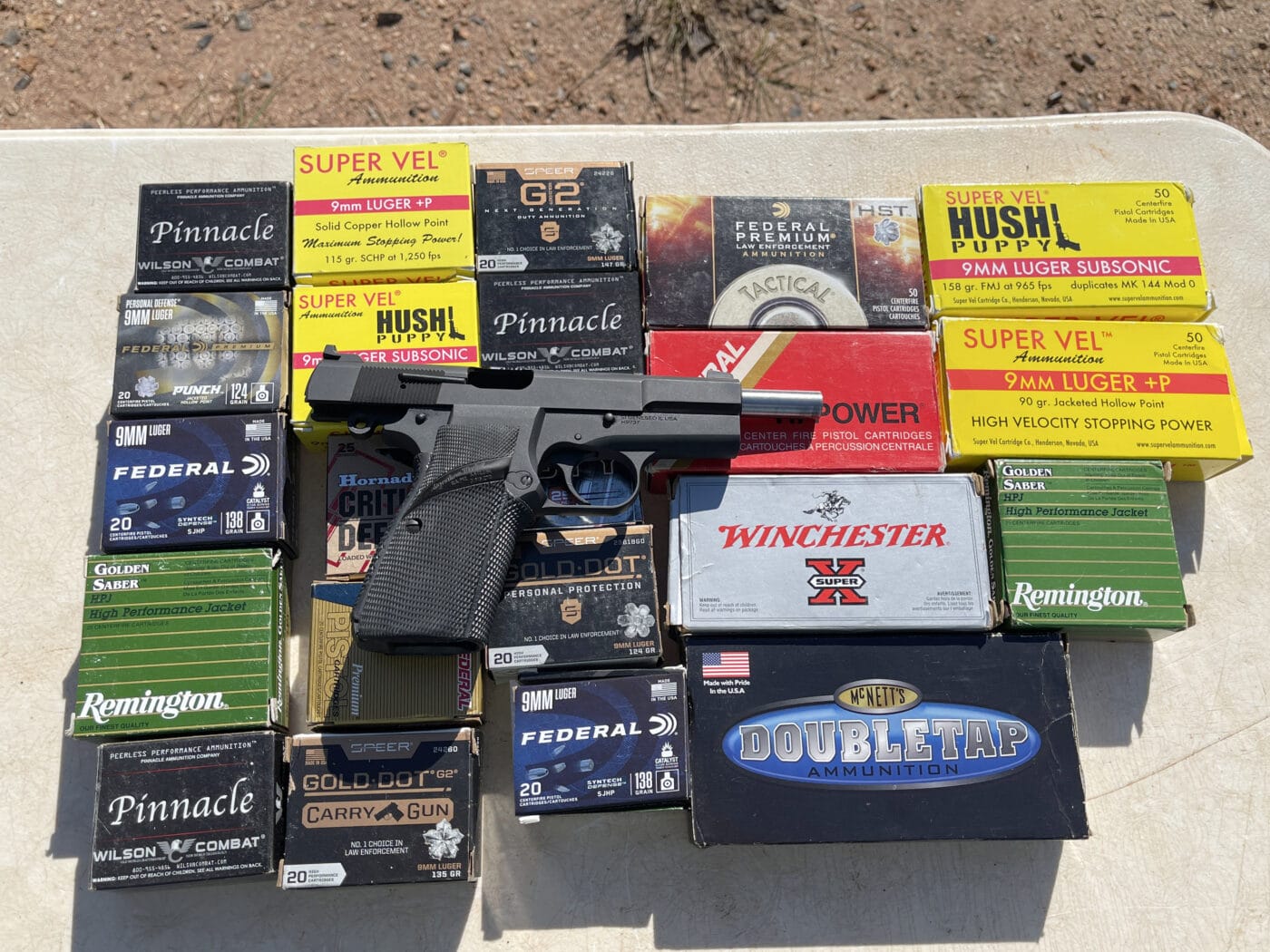
The first stage of the test was to evaluate the SA-35 for reliability. I dug way back in the ammo bunker and was able to gather 21 different loads. These ranged from new production Super Vel 90-gr. +P to vintage Winchester 115-gr. Silvertip and Federal 115-gr. 9BP. I also included as many current production, premium loads, as possible.
The test protocol was to shoot 10 rounds from each load. To evaluate reliability, I loaded five rounds in the bottom of the magazine, followed by five ball rounds, and then five rounds at the top. The thought was that most malfunctions either occur in the first few or the last few rounds of the magazine. This also reduced the total rounds of premium ammo needed for this part of the evaluation.
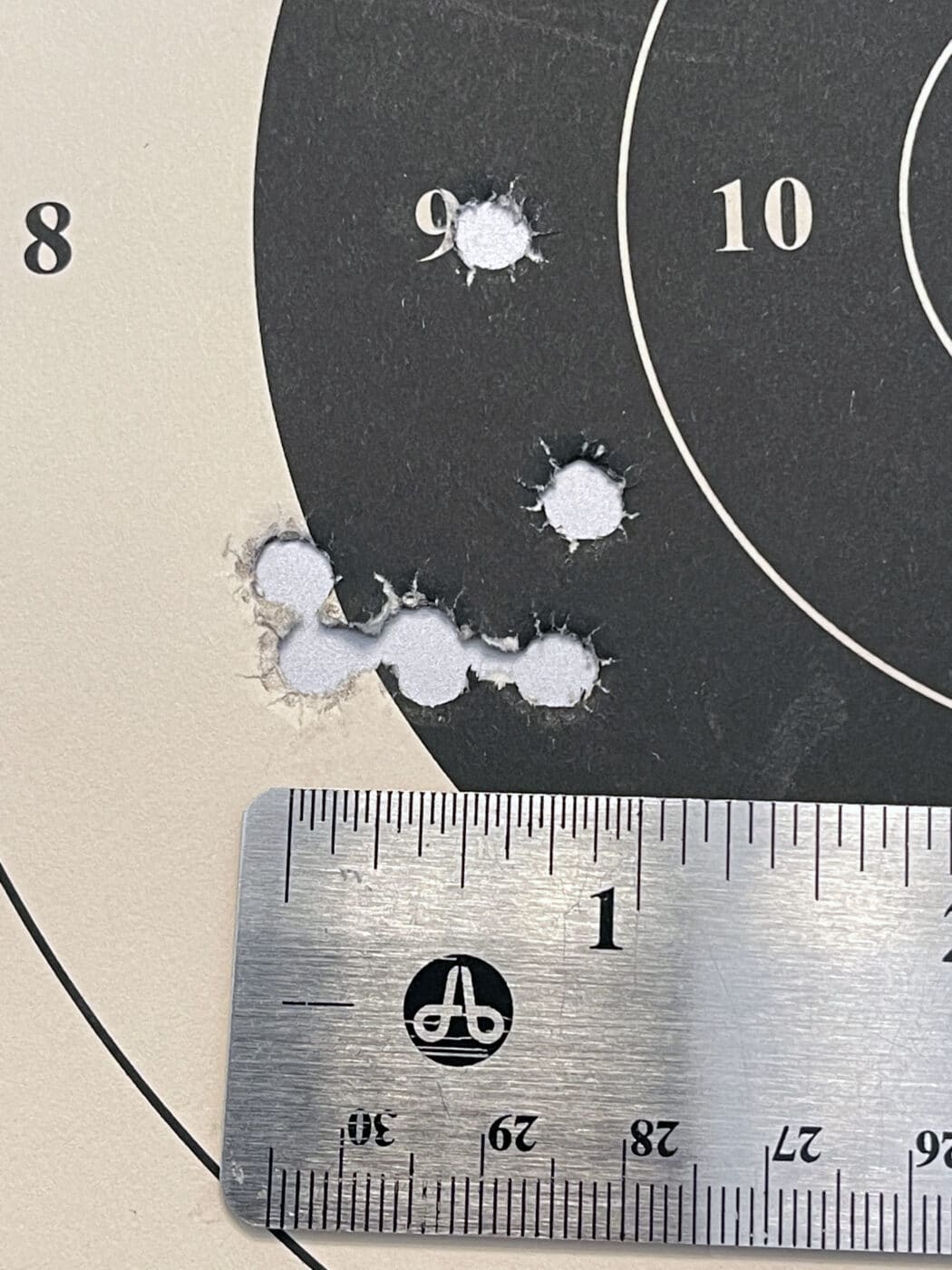
The 10 rounds were fired from a bag rest at a B-8 bullseye target, positioned 25 yards downrange. They were also shot through my ProChronoDLX chronograph. The hottest load was the Double Tap 80-gr. TAC-XP, which averaged 1,471 fps. The Super Vel 158-gr. Hushpuppy Subsonic load was the slowest at 891 fps. I had no ammo-related issues during this phase of the test.
To evaluate the accuracy, I measured the best five-shot group. This mitigated shooter error and was a better reflection of the potential accuracy of the SA-35. The reader will note the N/A comment on the chart. There were a couple of times when I failed to replace the target between loads. As the chart reflects, the SA-35 is certainly capable of providing 2″ or better groups, with most loads.
Ammunition Performance Results
| Ammunition | Velocity | Energy | Group Size |
| DoubleTap Tac-XP 80 gr HP | 1,405 fps | 351 ft-lbs | 1.5″ |
| Federal HST 124 gr JHP | 1,180 fps | 383 ft-lbs | 1.0″ |
| Federal Hydra-Shok 147 gr JHP | 980 fps | 313 ft-lbs | 2.5″ |
| Federal Premium 115 gr JHP | 1,148 fps | 337 ft-lbs | 1.5″ |
| Federal Punch Personal Defense 124 gr JHP | 1,189 fps | 389 ft-lbs | 1.37″ |
| Federal Syntech Defense 138 gr JHP | 1,081 fps | 358 ft-lbs | n/a |
| Hornady Critical Defense 115 gr FTX | 1,160 fps | 344 ft-lbs | n/a |
| Hornady Critical Duty 124 gr FTX +P | 1,208 fps | 402 ft-lbs | 1.88″ |
| Remington Golden Saber 124 gr BJHP | 1,130 fps | 352 ft-lbs | 1.5″ |
| Remington Golden Saber 124 gr BJHP +P | 1,179 fps | 383 ft-lbs | 1.0″ |
| Speer Gold Dot G2 135 gr GDHP | 1,122 fps | 377 ft-lbs | 1.0″ |
| Speer Gold Dot G2 147 gr GDHP | 1,022 fps | 341 ft-lbs | 1.37″ |
| Speer Gold Dot Personal Protection 124 gr GDHP | 1,156 fps | 368 ft-lbs | 1.75″ |
| Super Vel Mk144 Mod 0 Subsonic 158 gr | 891 fps | 278 ft-lbs | 2.0″ |
| Super Vel 90 gr SCHP +P | 1,572 fps | 494 ft-lbs | 2.0″ |
| Super Vel 115 gr SCHP +P | 1,241 fps | 393 ft-lbs | 1.25″ |
| Super Vel Subsonic 115 gr | 1,093 fps | 305 ft-lbs | n/a |
| Wilson Combat TAC-XP 95 gr HP | 1,282 fps | 347 ft-lbs | 1.75″ |
| Wilson Combat TAC-XP 115 gr HP +P | 1,101 fps | 310 ft-lbs | 2.0″ |
| Winchester Silvertip 115 gr JHP | 1,164 fps | 346 ft-lbs | 1.5″ |
Pushing the Handgun Farther
The second round of tests involved evaluating the extractor and ejector, the reliability when shooting with a less than firm grip, and functioning with mixed loads left over from the first test.
About 100 rounds in, we did notice that the rear sight retention screw had worked loose. This was a quick fix with the proper wrench. This was the only issue we had with the actual pistol.
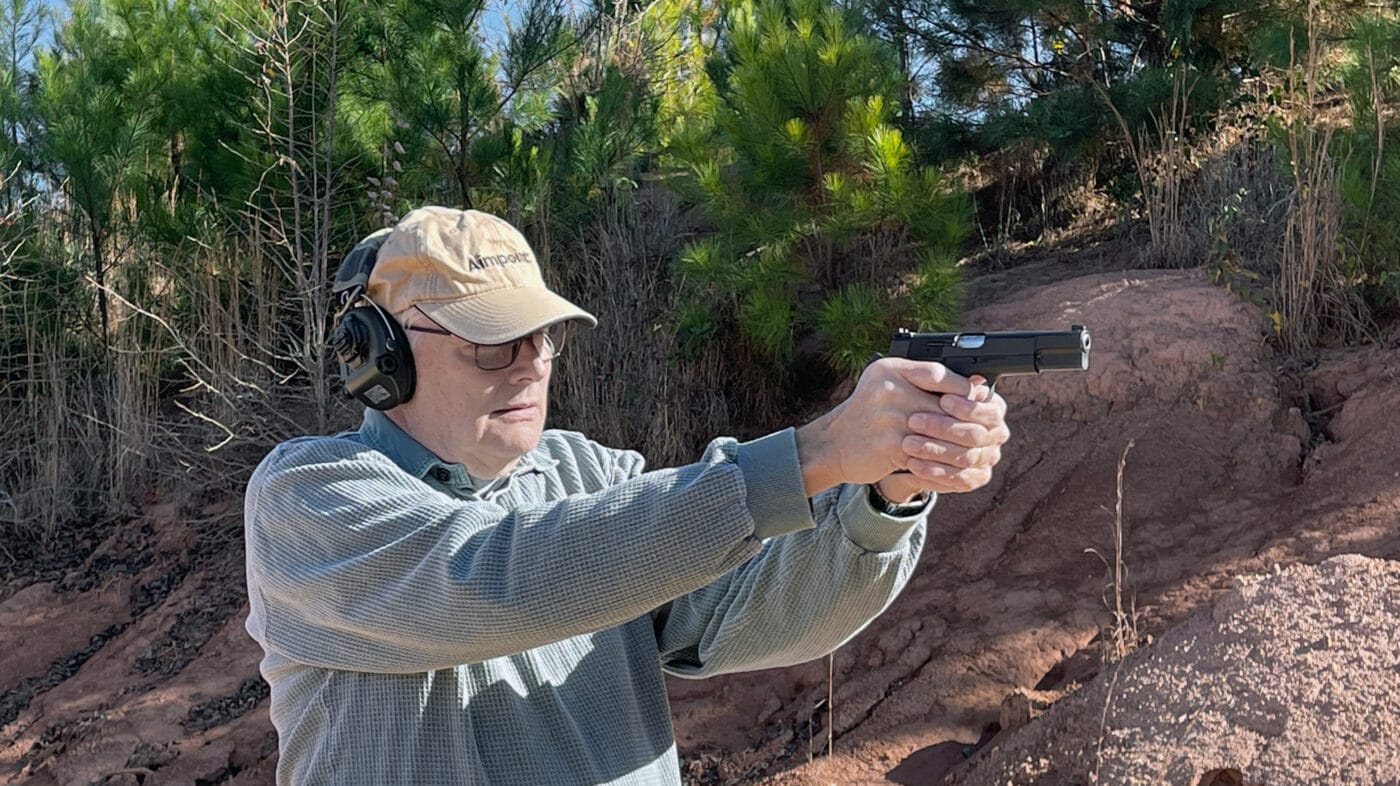
To evaluate the extractor and ejection pattern, I fired 15 rounds of 115-gr. ball. Each round was fired without having a magazine in the gun. All rounds landed at three to four feet, between 3:30 and 5:00 from the pistol.
The final test consisted of an extended 20-round magazine dump to heat the gun up, followed by three 15-round magazines, shot rapidly. The three magazines contained a mixed selection of the loads tested for accuracy. These loads were all considered premium personal defensive loads.
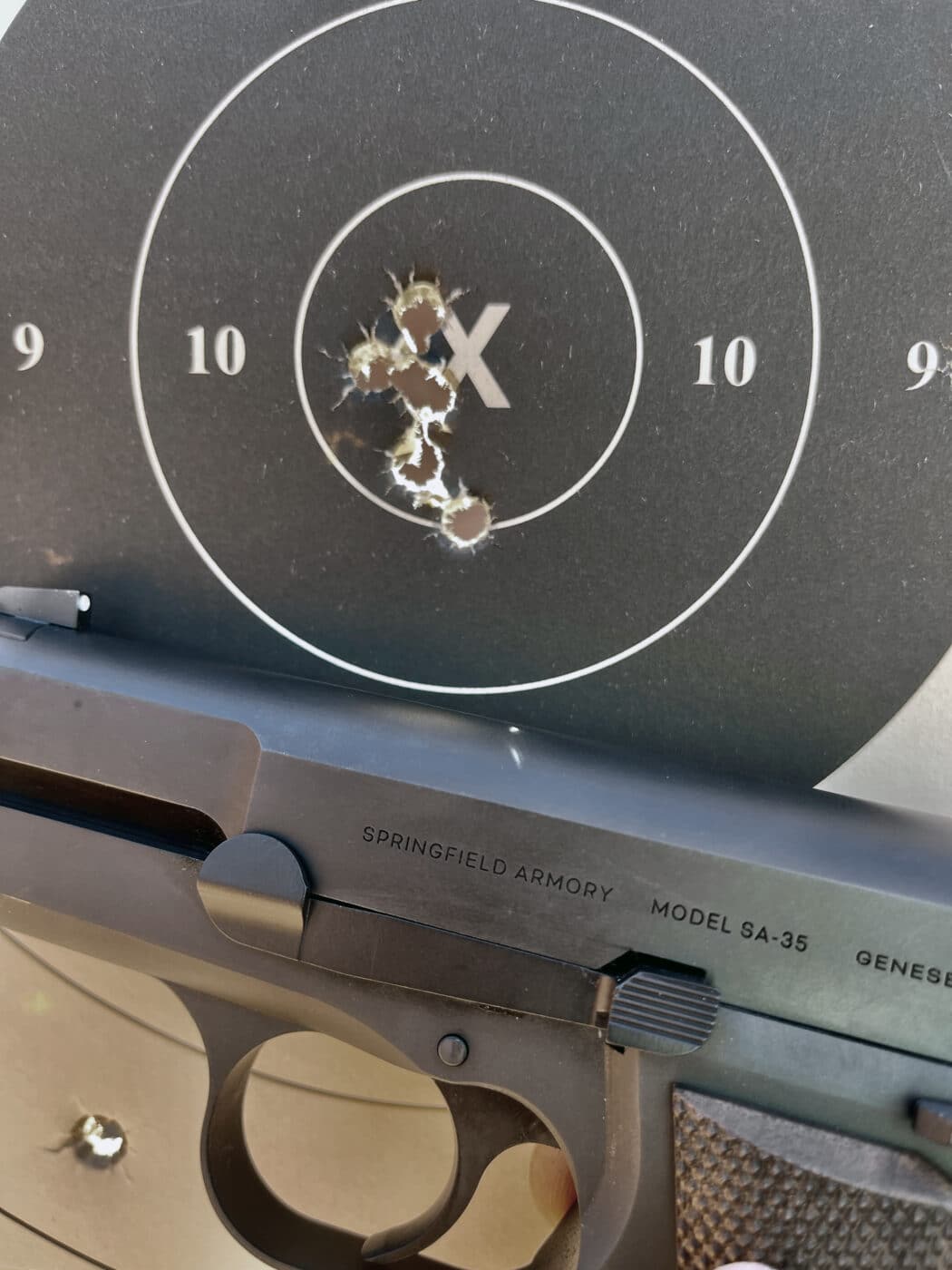
During this test, we had one failure. On the second magazine, one Super Vel 90 gr. +P JHP hung up on the feed ramp and failed to feed. It should be noted that the overall length of this round is extremely short as well as being loaded to +P velocities. This was the only malfunction we had in the entire test series.
We finished on the day popping plates and ringing steel, with leftover loads, and the total round count for the day was around 450 rounds. We did not clean or lube the pistol during this process.
Wrap Up of the SA-35 Review
I consider the information that I gathered during this testing to be significant. With the exception of the aforementioned Super Vel load, the SA-35 was 100% reliable with all of the relevant personal defense loads. An examination of the frame, slide, and barrel, showed no excessive wear or peening. This was a pretty intensive test for one day of shooting, with an extremely broad range of bullet weights and loads.
The only negative comment anyone had during the test was that top edges of the backstrap were extremely sharp and somewhat uncomfortable during shooting. This is an easy fix for Springfield on future guns.
Thanks for coming along on the trip. There will be more to come.
Additional information on the Springfield Armory SA-35 Review
Measured Trigger-Pull Weight
To quantify the SA-35’s single-action trigger, we used a calibrated digital trigger gauge and recorded ten consecutive pulls from the center of the shoe with the pistol cleared and pointed in a safe direction. The pistol was inspected, lightly lubricated, and measured with an empty magazine inserted to replicate typical range conditions. We discarded obvious outliers and averaged the remaining pulls to get a realistic number for readers.
Across our ten-pull series, the Springfield Armory SA-35 produced an average trigger-pull of 5 lb 10 oz, with a low of 5 lb 7 oz and a high of 5 lb 14 oz. Take-up is short and smooth before a defined wall; the break is clean with minimal overtravel. Reset is positive and short, making rapid follow-up shots easy to time. Importantly, the pull weight remained consistent as the session progressed, suggesting solid sear-to-hammer engagement and stable spring tension.
On the range, this trigger weight strikes a good balance between duty-ready safety margins and practical accuracy. Shooters accustomed to Hi-Power-pattern pistols will appreciate the familiar ergonomics, while the SA-35’s geometry and surfaces deliver a crisp break that rewards clean press mechanics. After approximately 50 rounds, the trigger subjectively felt slightly smoother, which is consistent with normal wear-in of mating surfaces.
Key notes for readers comparing models: this SA-35 sample demonstrated predictable take-up, a distinct wall, a clean break, and a tactile reset — attributes that support controlled pairs and precise slow-fire work. If you prefer a lighter or heavier pull for competition or carry, consult a qualified armorer; any modification should preserve safe sear engagement and reliable primer ignition.
SA-35 Parts & Holster Interchangeability
One advantage of the SA-35 is its broad compatibility with the Hi-Power ecosystem. In our checks, most quality Hi-Power holsters and several small parts worked as expected, while a few items required model-specific attention.
Hi-Power Holsters
The SA-35 matched well with molded leather and Kydex rigs marked for the Browning/FN Hi-Power. The slide and frame profiles follow the classic pattern, so most IWB/OWB holsters that are not optic-cut seated and retained normally. As with any tightly molded Kydex, verify clearance at the trigger guard and dustcover before daily carry and adjust retention screws to prevent drag on the extended thumb safety.
Magazines
Standard Hi-Power 13-round magazines locked, fed and dropped free in our sample. Modern 15-round Hi-Power-pattern magazines also functioned normally. Always confirm reliable lock-back and drop-free behavior with your specific mags before carry, as baseplate dimensions and spring tension can vary by maker and batch.
Grips
Grip panels marketed for the Hi-Power generally aligned with the SA-35’s screw spacing and frame contour. Check panel thickness if you prefer a slimmer profile — some legacy wood grips are noticeably thinner or thicker, which changes reach to the trigger and safety.
Sights
The SA-35 uses dovetailed sights. Many legacy Hi-Power front sights were staked, while later variants used differing dovetails. If you’re upgrading, select sights listed specifically for the SA-35 or confirm dovetail specs with the manufacturer. Install with proper support and a sight pusher to avoid marring the finish.
Controls & Small Parts
Extended or “classic” Hi-Power slide stops and safeties may appear similar, but not all are true drop-ins due to dimensional and heat-treat differences between eras and makers. Test fit with a qualified armorer to ensure proper sear engagement, positive detents, and full safety function. The SA-35 deletes the magazine disconnect, so legacy trigger parts designed around that system may not translate one-to-one.
Left-Handed Use
Most Hi-Power holsters remain right-hand focused. Southpaws should verify that their chosen holster allows a clean draw stroke and that the safety is protected from inadvertent movement. If you require an ambidextrous safety, source a unit specifically listed for the SA-35 and confirm safe function before live fire.
Bottom Line
For everyday use, holsters and magazines labeled for the Hi-Power have been the most seamless fit with the SA-35, while sights and certain controls benefit from SA-35-specific part numbers. As always, confirm compatibility at the bench and on the range before trusting any component for defensive carry. SA-35 holster compatibility, Springfield Armory SA-35 parts, Hi-Power magazines, Hi-Power grips, Hi-Power sights, ambidextrous safety, Browning Hi-Power holster fit.
Competing Hi-Power Options: Why the Springfield Armory SA-35 Is the Top Choice
The SA-35 sits at the center of today’s Hi-Power field and, for most shooters, is the superior option. It blends classic ergonomics with smart updates, strong out-of-box reliability, broad holster and magazine compatibility, and an attainable price point backed by modern factory support. If you want the Hi-Power experience without compromises, this is the benchmark to beat.
FN High Power: Modernized But a Different Direction
FN’s current High Power is a thorough re-work with larger dimensions, a different internal architecture, and a higher-capacity magazine system. It offers ambidextrous controls and contemporary ergonomics, but it diverges from the traditional Hi-Power feel and parts ecosystem. For buyers who want a fully reimagined pistol, FN is compelling; for those seeking true Hi-Power handling with refined execution, the SA-35 delivers the more authentic experience with fewer fitment surprises and wider holster/mag support.
Girsan MC P35 Series: Value Priced with Variable Refinement
Girsan’s MC P35 lineup spans classic slides to optic-ready and rail variants at attractive prices. Features can be generous, but fit, finish, and small-parts consistency vary by trim and production batch. Compared head-to-head, the SA-35 provides crisper triggers, cleaner machining, and more consistent reliability out of the box — advantages that reduce the need for immediate upgrades.
Tisas and Other Imports: Traditional Feel with Caveats
Tisas and Legacy Imports preserve the steel-frame tradition and often use modern sight cuts and feed-ramp geometry. Availability and small-parts specs, however, can differ across runs, which makes long-term support and drop-in compatibility less predictable. The SA-35 counters with stable specifications, ready access to holsters and magazines, and factory backing that simplifies ownership.
Why the SA-35 Wins for Most Shooters
1. Authentic Hi-Power ergonomics with smart updates: improved sights, refined trigger characteristics, and the removal of the magazine disconnect for a cleaner break.
2. Broad ecosystem fit: excellent holster compatibility with Hi-Power-marked rigs and reliable performance with common Hi-Power-pattern magazines.
3. Consistent quality control: machining, finish, and small-parts fit that typically require less post-purchase tuning.
4. Practical value: premium feel and performance without the price or dimensional departures of more radical redesigns.
Bottom line: across authenticity, shootability, ecosystem compatibility, and day-one reliability, the Springfield Armory SA-35 is the superior Hi-Power–pattern choice for most users.
Article Updated: October 16, 2025
Editor’s Note: Please be sure to check out The Armory Life Forum, where you can comment about our daily articles, as well as just talk guns and gear. Click the “Go To Forum Thread” link below to jump in and discuss this article and much more!
Join the Discussion
Featured in this article
Continue Reading
Did you enjoy this article?

 831
831




